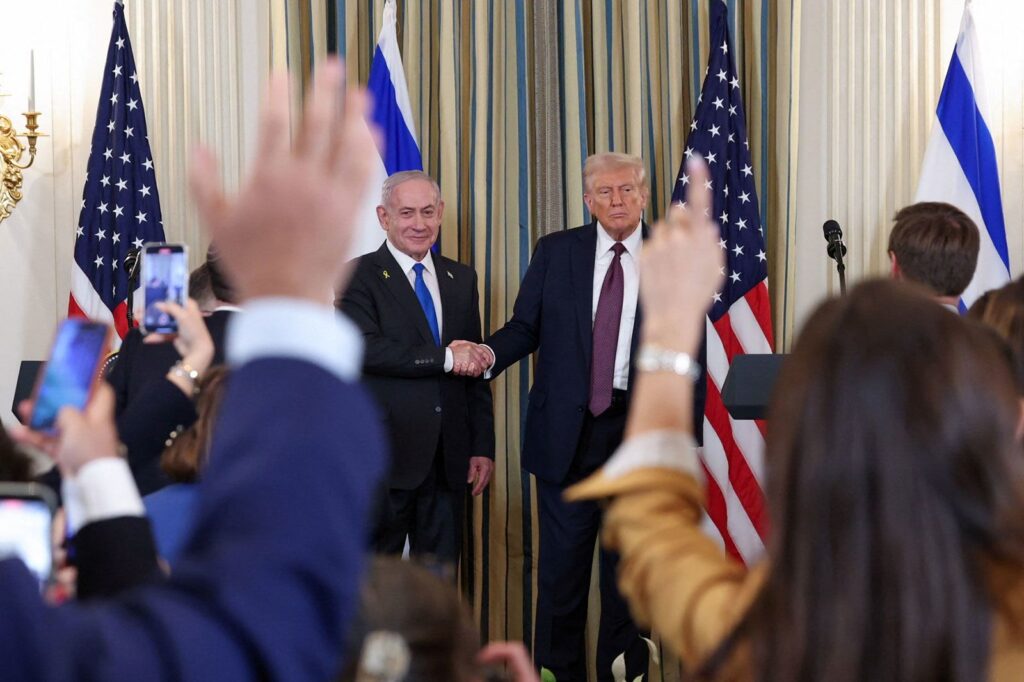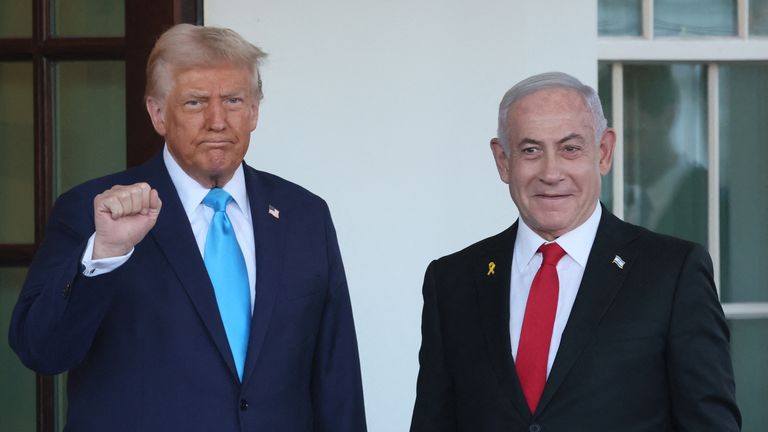The world is holding its breath as negotiators meet in Egypt for crucial talks aimed at finalizing a ceasefire and hostage deal to end the nearly two-year-old conflict in Gaza. On the eve of these indirect negotiations, a confident tone emanated from Washington. With President Donald Trump declaring that the peace talks will progress “very quickly” and could see the first phase completed this week. Trump Predicts
Trump’s optimism follows a week of high-stakes diplomatic pressure. Culminating in a response from Hamas that signaled a partial acceptance of the United States’ comprehensive 20-point peace plan. While deep, core disagreements between the parties remain, the convergence on the central issue—the release of remaining hostages—has created a crucial window of opportunity that the White House is pushing to close swiftly and decisively.
The Trump Plan: An Ultimatum That Broke the Deadlock Trump Predicts
The current wave of diplomatic activity began after President Trump unveiled a detailed 20-point proposal designed to free the remaining hostages held in Gaza and end Israel’s military campaign. This plan is ambitious. Covering everything from immediate cessation of hostilities and hostage-prisoner exchanges to the disarmament of Hamas and the postwar governance of Gaza.
The President’s strategy has marked by an ultimatum. On Friday, he warned Hamas to accept the peace deal by Sunday evening, or face “all HELL, like no one has ever seen before.” This immense pressure seemingly forced a breakthrough.
On Friday, Hamas released a statement indicating a willingness to release all Israeli hostages—both living and deceased—in exchange for Palestinian prisoners. Provided “necessary field conditions” have met. This was a significant shift, acknowledging the core exchange framework proposed by Washington.
Trump immediately welcomed the statement, declaring on social media, “I believe they are ready for a lasting PEACE.” He then issued a sharp directive to Israel: “Israel must immediately stop the bombing of Gaza, so that we can get the Hostages out safely and quickly! Right now, it’s far too dangerous to do that.”
Israeli Prime Minister Benjamin Netanyahu quickly backed the initial phase of the deal. Confirming that Israel was preparing for “the immediate release of all the hostages” and that negotiators would travel to Egypt “to finalise the technical details.” Netanyahu expressed hope that the releases would be secured “during the Sukkot holidays,” which began Monday.

The Urgency from Washington: “Move Fast” Trump Predicts
The central theme from the White House over the weekend was one of relentless speed. President Trump stressed that “TIME IS OF THE ESSENCE OR, MASSIVE BLOODSHED WILL FOLLOW.”
In a Sunday statement, the President highlighted the rapid pace of the preliminary discussions: “These talks have been very successful, and proceeding rapidly. The technical teams will again meet Monday, in Egypt, to work through and clarify the final details.”
The goal, as publicly stated by Trump, is to complete the first phase of the agreement—focused on the hostage and prisoner exchange—“this week.”
To ensure progress, the President dispatched two of his top envoys. Including Jared Kushner and Steve Witkoff, to Egypt to assist in sealing the deal. Secretary of State Marco Rubio affirmed that the first phase, the logistics of the hostage release. Is the “most emergent and immediate phase” of the plan. With the hard work already underway.
The 20-Point Plan: Hostages, Disarmament, and Governance is
Trump’s plan is far more than a simple hostage exchange. It is a blueprint for the complete overhaul of Gaza’s political and military landscape.
1. The Hostage-Prisoner Exchange
The immediate priority have released of the remaining 48 Israeli hostages (approximately 20 of whom are believed to be alive). Under the plan:
- Hamas would release all hostages within 72 hours of the agreement taking effect.
- In return, Israel would free 250 Palestinians serving life sentences and 1,700 people detained since the war began. Including all women and children.
Crucially, Trump announced on Saturday that Israel has agreed to an “initial withdrawal line” in Gaza. Which has been shared with Hamas. If Hamas confirms acceptance of this line, the ceasefire would become “IMMEDIATELY effective.”
2. The Great Divide: Disarmament and Future Governance
Despite the progress on the hostage issue. The ultimate fate of the Gaza Strip and Hamas itself remains the biggest sticking point. The U.S. plan requires sweeping concessions from the militant group that it has historically refused to consider:
- Disarmament of Hamas: The plan mandates that Hamas disarm completely, with its military infrastructure, including tunnels, being dismantled. Hamas’s public statements on the deal have conspicuously omitted any reference to disarmament, signaling opposition to giving up its weapons. Both Trump and Netanyahu have insisted that this is non-negotiable.
- Administration of Gaza: The U.S. plan dictates that Hamas would have no role in governing Gaza. The territory would be run by an interim administration of Palestinian technocrats. Overseen by a new “Board of Peace,” an international transitional authority that would include the U.S. President and potentially former British Prime Minister Tony Blair. Hamas has rejected this model, proposing instead a Palestinian technocratic body based on national consensus.
- Troop Withdrawal: While Israel has agreed to an “initial withdrawal line,” the U.S. plan links the full. Staged withdrawal of Israeli troops to the disarmament of Hamas and the deployment of an International Stabilization Force (ISF). Hamas, conversely, demands a complete withdrawal of Israeli forces from Gaza before any final agreement.
The Irony of Negotiation: Bombing Amid Ceasefire Hopes Trump Predicts
The intensity of the negotiations was underscored by the fact that even after Trump’s direct order to “immediately stop the bombing,” Israeli strikes continued in Gaza. Reports on Sunday indicated that dozens of air strikes and artillery shelling hit Gaza City and other areas, resulting in further casualties.
This continuation of the military campaign highlights the deep distrust and the precarious nature of the negotiations. For Hamas, the demand for a permanent ceasefire and total Israeli withdrawal is a matter of survival. For Israel, the insistence on Hamas’s disarmament and the elimination of any future military threat is paramount to its security. The fact that the technical teams were meeting in Egypt to negotiate a ceasefire while military activity continued on the ground demonstrates the high-risk, high-reward approach of the current diplomatic push.
International Response and the Path Forward
The renewed push for peace has been widely welcomed by the international community. European leaders, the United Nations, and foreign ministers from key Arab and Muslim-majority countries have expressed strong support for the Trump plan. Urging all parties to seize this “last chance” opportunity.
The talks convening in Egypt—with senior delegations from Israel, Hamas, Qatar, Turkey, and Egypt—are now tasked with closing the seemingly intractable gaps on the issues of disarmament. The final withdrawal of Israeli forces and the nature of post-war governance.
Secretary of State Marco Rubio cautioned that while the initial hostage-release phase is achievable quickly. The second, harder part of establishing a non-Hamas government and ensuring the full disarmament of the militant group will “take work and some time.”
Despite the complexities, President Trump remains unwavering in his optimism. Betting that the intense pressure and the catastrophic humanitarian situation in Gaza will compel all sides to move with the urgency required. His public assurance that the talks will go “very quickly” sets a demanding pace for negotiators and raises hope that a path out of the decades-long conflict. However fragile, it is finally within sight. The world waits to see if this diplomatic sprint can truly achieve the “lasting peace” that has long evaded the region. Trump Predicts
Read More Articles Click Here.
